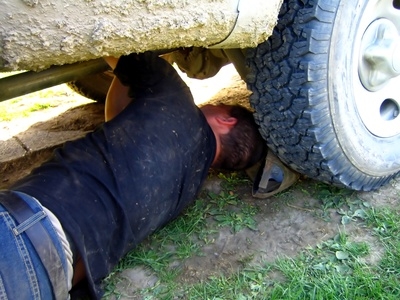
The exhaust system has the important job of directing and expelling combustion gases from the engine out the tailpipe. Sometimes restrictions block the flow of burnt gases and cause leaks. Other times the exhaust system pipes and components can loosen at their connections, which can cause leaks that can be seen and heard. The exhaust system starts with the exhaust manifold and ends at the tailpipe. Everything between the front and rear of the exhaust system can be checked for leaks and repaired.
The exhaust manifold gasket takes a lot of punishment in the form of expansion and contraction. The gasket can fail due to the stresses and pressures it must endure and usually gives warning signs. Hissing or popping noises coming from the manifold indicate a possible leak. Any black soot in and around the manifold mating surface to the head indicates escaping exhaust gases. Look for melted plug wires, where excessive heat has caused burning. Another indicator will be the release of carbon monoxide that enters the passenger compartment. Carbon monoxide fumes can cause dizziness, nausea and confusion. Cracked exhaust manifolds can emit loud rumbling or "plapping" noises, sometimes in a very low frequency.
The manifold to header pipe connection typically has a large graphite gasket or a metal ball and socket-type flange. On vehicles with front-wheel drive, this joint takes a lot of flexing from engine movement during shifting and hard acceleration, causing the joint to flex and wear out. Leakage from this gasket joint will often cause very loud rumbling sounds and smell like unburned fuel. Black smoke can sometimes emit from this joint. Any discoloration at this joint like soot-streaking or black carbon buildup will point to a bad manifold to header pipe junction. Once again, carbon monoxide will be a real danger in this area.

The catalytic converter re-burns excessive fuel that has come from the combustion chamber by using extreme heat and a chemical reaction. If it gets too hot it will discolor on the outside casing (underneath the shields), showing a multi-colored rainbow pattern, a sign that it has burnt internally. The chemical pellets inside the converter will give off a rotten egg smell when the engine has warmed up. A clogged or saturated converter will create huge back-pressure that will send exhaust gases backwards and out through points of least resistance like the manifold to header joint or the exhaust manifold gasket. A bad catalytic converter should be replaced immediately.
Mufflers and resonators dampen exhaust noise and can be found mounted mid-way under the chassis or at the extreme end near the tailpipe. They collect the most water condensation and can rust from the inside out. Sometimes drain holes can been seen on their bottom casings. Any rusty water dripping out of the drain holes indicates interior rusting, where the baffle plates have deteriorated. Mufflers and resonators typically rust starting at the bottom. So any flaking or rotted metal indicates a partial or full failure of the interior structure and a leak can be expected in this area before too long.
Any place in the exhaust system where a clamp couples a pipe to a muffler, catalytic converter or resonator can weaken and break. Joints will give way first, whether mechanically sealed or welded. Other suspect areas for leaks will include locations where any sharp bends exist in the pipe, like the over-the-axle loop. Pipe and muffler hangers can break free and let the exhaust hang, hitting and abrading other parts of the chassis, eventually causing mechanical damage.